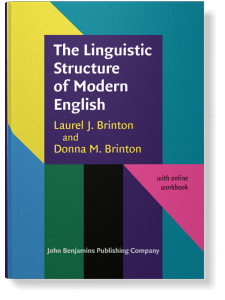The Linguistic Structure of Modern English
This text is for advanced undergraduate and graduate students interested in contemporary English, especially those whose primary area of interest is English as a second language, primary or secondary-school education, English stylistics, theoretical and applied linguistics, or speech pathology. The emphasis is on empirical facts of English rather than any particular theory of linguistics; the text does not assume any background in language or linguistics. In this newly revised edition numerous example sentences are taken from the Corpus of Contemporary American English. A full glossary of key terms, an additional chapter on pedagogy and new sections on cognitive semantics and politeness have been added. Other changes include: completely updated print references; web links to sites of special interest and relevance; and a revised, reader-friendly layout. A companion website that includes a complete workbook with self-testing exercises and a comprehensive list of web links accompanies the book. The website can be found at the following address: https://doi.org/10.1075/z.156.workbook.
Students completing the text and workbook will acquire: a knowledge of the sound system of contemporary English; an understanding of the formation of English words; a comprehension of the structure of both simple and complex sentence in English; a recognition of complexities in the expression of meaning; an understanding of the context and function of use upon the structure of the language; and an appreciation of the importance of linguistic knowledge to the teaching of English to first and second-language learners.
Laurel J. Brinton is Professor of English Language at the University of British Columbia.
Donna M. Brinton is Senior Lecturer in TESOL at the University of Southern California's Rossier School of Education.
The Linguistic Structure of Modern English is a revised edition of The Structure of Modern English by Laurel J. Brinton (2000).
The Structure of Modern English: A linguistic introduction, Laurel J. Brinton (2000)
Table of Contents
-
Preface to the second edition | pp. i–xx
-
Chapter 1. The nature of language and linguistics | pp. 1–15
-
Chapter 2. Consonants and vowels | pp. 16–49
-
Chapter 3. Phonology, phonotactics, and suprasegmentals | pp. 50–78
-
Chapter 4. The internal structure of words and processes of word formation | pp. 79–112
-
Chapter 5. Grammatical categories and word classes | pp. 113–142
-
Chapter 6. Lexical semantics | pp. 143–183
-
Chapter 7. Phrasal structure and verb complementation | pp. 184–215
-
Chapter 8. Adverbials, auxiliaries, and sentence types | pp. 216–242
-
Chapter 9. Finite and nonfinite clauses | pp. 243–293
-
Chapter 10. Sentence semantics | pp. 294–323
-
Chapter 11. Information structuring and speech acts | pp. 324–355
-
Chapter 12. Linguistics in language teachingHoward Williams | pp. 356–384
-
References | pp. 385–392
-
Glossary | pp. 393–415
-
Appendices | pp. 416–419
Erratum
Erratum Tables 8.1 & 8.2
Please find here Tables 8.1 & 8.2 as they should appear on pages 225 and 228.
Cited by
Cited by 42 other publications
This list is based on CrossRef data as of 21 march 2024. Please note that it may not be complete. Sources presented here have been supplied by the respective publishers. Any errors therein should be reported to them.

